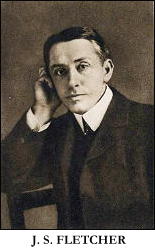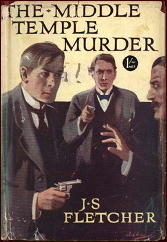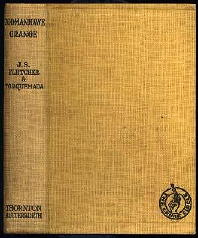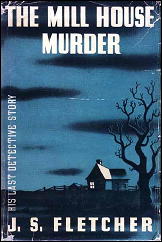Fri 3 Dec 2010
Reviewed by Curt Evans: J. S. FLETCHER – Todmanhawe Grange.
Posted by Steve under Authors , Reviews[5] Comments
J. S. FLETCHER – Todmanhawe Grange. Thornton Butterworth, UK, hardcover, 1937. US title: The Mill House Murder, Alfred A. Knopf, 1937.

The final mystery novel by the extremely prolific mainstream and mystery genre novelist J. S. Fletcher, Todmanhawe Grange was published posthumously, two years after the seemingly indefatigable author’s death in 1935 at nearly seventy-two years of age.
Completed by Edward Powys Mathers, aka Torquemada, the infamous crossword puzzle creator and crime fiction reviewer for the London Observer (who himself died at the age of forty-six four years later), Todmanhawe Grange is, surprisingly enough, given that it came at the end of a long line of over eighty Fletcher mystery novels, the best Fletcher crime tale I have read.
J. S. Fletcher turned to the mystery and thriller genre in 1901, after enjoying some success as a mainstream novelist, particularly as a regionalist in the manner of Thomas Hardy and Eden Phillpotts. Though Fletcher continued to write mainstream novels (largely about his native Yorkshire), mystery tales increasingly dominated his output, especially after the publication in 1919 of The Middle Temple Murder, the mystery famously praised by President Woodrow Wilson.

Alfred Knopf, Fletcher’s canny American publisher, never tired of reminding the reading public of this fact; and whether because of this or some other reason (Knopf’s publicity campaign probably was the best by an American publisher prior to Charles Scribners’ promotion of S. S. Van Dine in the second half of the 1920s), Fletcher became known for a time in the United States as the greatest English mystery writer after Arthur Conan Doyle (this view was not shared in England).
Fletcher, who naturally enjoyed the money this publishing success was bringing in, responded by producing ever more works of mystery fiction, both novels and short story collections. Many of his earlier, pre-Middle Temple Murder mystery novels that had not originally published in the United States were reprinted at this time as well (without informing readers that they were reprints), resulting in the regular publication of four or more Fletcher mystery volumes a year. Not for nothing did critics refer to the “Fletcher Mill.”
By the 1930s the Fletcher vogue had passed and Fletcher was seen even in America as a passe, unexciting writer. Better detective novelists like S. S. Van Dine, Ellery Queen, Agatha Christie, Dorothy L. Sayers, Anthony Berkeley, John Rhode, J. J. Connington, and Freeman Wills Crofts had become well-known, and simultaneously Fletcher’s mysteries, never the most inspired in truth, largely had become ever more mechanical and dull.

After his death, his books quickly fell out of print and today he survives in mystery genre history essentially as a one-work writer, the author of The Middle Temple Murder (praised — did I mention? — by Woodrow Wilson).
So imagine my surprise when I read Todmanhawe Grange and found that it was quite good, succeeding both as a puzzle and a crime novel of atmosphere and local color.
Surely some of the credit for the merit of the puzzle must go to Torquemada (Fletcher tended to be a loose mystery plotter, often eschewing the fair play convention of the Golden Age), yet the novel is as well the most atmospheric and engrossing crime tale that Fletcher had written in some years.
In Todmanhawe Grange, we read of the last exploit of Ronald Camberwell, a private inquiry agent introduced by Fletcher late in his writing career, in 1931. Camberwell himself is not particularly interesting, but the setting, a Yorkshire mill town, is very well-conveyed, as are the people residing there.
The murder centers around the affairs of James Martenroyde, head of wealthy textile manufacturing family. Martenroyde, affianced to a much younger woman, contacts Camberwell’s firm to investigate certain delicate matters. The blustery night of Camberwell’s arrival in the mill town, John Martenroyde is found dead in the mill weir. His death, of course, is not a natural one.

Two additional murders follow — as well as Fletcher’s much-loved lengthy inquests — and the reader is kept engaged throughout all these events, even the inquests (much of the second inquest was written by Torquemada, who provides excellent material and forensic detail that Fletcher himself tended to scamp in his mysteries).
The tale takes a rather Gothic twist and ends up bearing some resemblance, interestingly, to something out of the mind of Ruth Rendell (writing as Barbara Vine).
As pointed out earlier, a goodly share of the credit for the success of Todmanhawe Grange must go to Torquemada, yet he wrote, according to his own admission, only the final quarter of the tale (except for the very last line, which followed Fletcher’s last dictates; the rest of the conclusion followed an outline).
For whatever reason, Fletcher seems to have put some extra effort into the last work, and the effort shows.
December 3rd, 2010 at 1:17 pm
Curt –
I like your passing comment drawing an analogy to this book and Rendell/Vine’s work. I am continually amazed by the books with nasty characters and writers whose crime tales deal with the “twisted” mind of the criminal I read from the 1920s and 1930s that cannot help but draw comparisons to the darker contemporary writers we all know so well. Many of my notes on books I have notations like these:
“reminds me of Minette Walters in her early days”
“foreshadows the unreliable narrator who would become almost cliché in the modern suspense novel we now have in the work of writers like Patrick MacGrath and Ruth Rendell”
“Dutton is fascinated with psychopathology. I find few writers of this era with such a morbid penchant, but there are countless writers like Rendell…”
This is why I enjoy reading and researching the early crime and detective novel more than I do reading contemporary work. It seems that the forgotten and neglected writers laid all the groundwork for what most people think were ideas and motifs created by innovative modern crime writers.
December 3rd, 2010 at 3:20 pm
J.F.
The fact is — can there be any dispute? — the Golden Age of Detection did NOT consist of only Cozy Mysteries. After a while you begin to wonder what percentage of 20s and 30s crime fiction actually was cozy. Was it even a a majority?
In any case, when it comes to researching early detective fiction, it looks as though you and Curt have a lot in common.
Hopefully we’ll hear quite a bit from both of you along these same lines as time goes on.
— Steve
December 3rd, 2010 at 6:07 pm
Yes, I agree that there was much more going on the Golden Age period than the country house cozy stereotype. Like I mentioned above, this Fletcher novel ends up having a plot resolution that would not have been out of place in a Barbara Vine (with modern tweaks). Fletcher is far from being one of my favorite Golden Age writers, but I thought this one had some very interesting elements. He was not at all a bad writer, but he often treated his mystery tales like hackwork. This one was better, however.
December 3rd, 2010 at 6:29 pm
Another thought in passing, sometimes you wonder why an American publisher decides that a title change from the British one is a good idea.
This time, though, I think it’s obvious.
I haven’t done an exhaustive search, but the primary sites that Google turns up, not having to do with the book, are addresses on
Todmanhaw Lane, Wigglesworth, Skipton, N Yorkshire.
How does one pronounce “Todmanhaw(e)”, anyone know?
December 4th, 2010 at 12:24 am
Fletcher had a lot of mystery titles like that earlier on, all after some building or location in the book: Paradise Court, Marchester Royal, Hardican’s Hollow, Lynne Court Spinney, Malvery Hold, Scarhaven Keep, Ravensdene Court.
Lynne Court Spinney got a succession of new American titles: The Mystery of Lynne Court, And Sudden Death, The Pedigreed Murder Case. It’s no accident, I suspect, that those titles have the words Murder and Death in them! Surprisingly Hardican’s Hollow wasn’t retitled, though that sounds as innocuous as Todmanhawe Grange. If the latter were to work as a title for a murder mystery it would need a creepy building on the cover.
At least Americans probably have some idea what a “grange” might be (back in the thirties they might have related it to the farmers organization)–how about a spinney? When I came across Gladys Mitchell’s “Groaning Spinney” some years back, I don’t believe I had any idea what a spinney was!